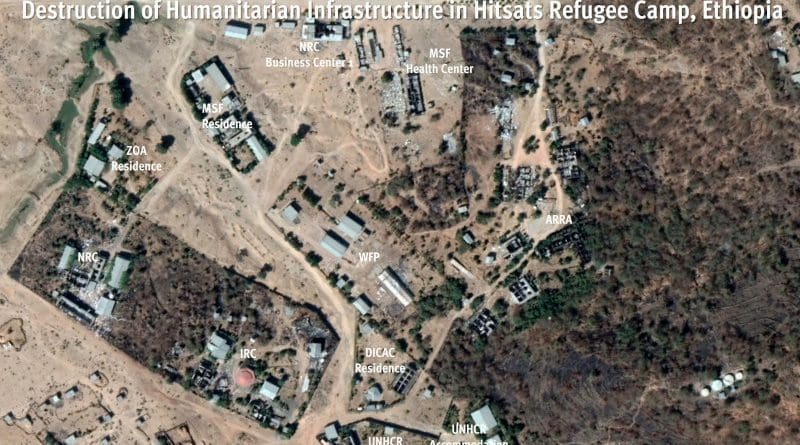Ethiopia: Eritrean Refugees Targeted In Tigray
Eritrean government forces and Tigrayan militias have committed killings, rape, and other grave abuses against Eritrean refugees in Ethiopia’s Tigray region, Human Rights Watch said. All warring parties should cease attacks against refugees, stay out of refugee camps, and facilitate the delivery of humanitarian aid.
Between November 2020 and January 2021, belligerent Eritrean and Tigrayan forces alternatively occupied the Hitsats and Shimelba refugee camps that housed thousands of Eritrean refugees, and committed numerous abuses. Eritrean forces also targeted Tigrayans living in communities surrounding the camps. Fighting that broke out in mid-July in Mai Aini and Adi Harush, the two other functioning refugee camps, again left refugees in urgent need of protection and assistance.
“Eritrean refugees have been attacked both by the very forces they fled back home and by Tigrayan fighters,” said Laetitia Bader, Horn of Africa director at Human Rights Watch. “The horrific killings, rapes, and looting against Eritrean refugees in Tigray are evident war crimes.”
Since January, Human Rights Watch has interviewed 28 Eritrean refugees: 23 former residents of Hitsats camp and 5 former residents of Shimelba camp, and 2 residents of the town of Hitsats who had witnessed the abuses by Eritrean forces and local Tigrayan militia. Human Rights Watch also interviewed aid workers and analyzed satellite imagery.
Human Rights Watch sent letters summarizing the findings and requesting further information to Ethiopia’s Agency for Refugees and Returnees Affairs (ARRA), the United Nations refugee agency (UNHCR), Eritrea’s permanent mission to the United Nations, and other international organizations in Geneva. Responses from ARRA and UNHCR are included below. Eritrea did not respond.
On November 19, Eritrean forces arrived in the town of Hitsats and indiscriminately killed several residents. They occupied and pillaged the town and took over the refugee camp. Some refugees took part in the looting, contributing to community tensions.
On November 23, Tigrayan militia entered Hitsats camp and attacked refugees near the camp’s Orthodox church. Clashes between the militia fighters and Eritrean soldiers ensued in and around the camp, lasting several hours. Nine refugees were killed and 17 badly injured.
One refugee said that Tigrayan militia fighters killed her husband as their family tried to seek shelter inside the church: “My husband had our 4-year-old on his back and our 6-year-old in his arms. As he came back to help me enter the church, they shot him.”
Two dozen residents in Hitsats town were also reportedly killed during and after the clashes that day. The Tigrayan militia retreated from Hitsats after the fighting.
Eritrean forces later detained approximately two dozen refugees in the camp and took them away in military vehicles. Their whereabouts have not been revealed. Eritrean forces also removed the 17 injured refugees from the camp, taking at least one – and likely others – back to Eritrea, ostensibly for treatment.
The Eritrean forces withdrew from the camp in early December. Tigrayan forces returned on the evening of December 5, shooting into the camp, and sending hundreds of refugees fleeing. In the ensuing days, Tigrayan militia attacked, arbitrarily detained, and sexually assaulted some of the refugees who had fled, notably around Zelazle and Ziban Gedena, north of Hitsats. They then marched the refugees back to Hitsats.
“I am a double victim,” said a 27-year-old woman whom Tigrayan militia fighters raped along with her 17-year-old sister while they fled Hitsats. “Both in Eritrea, and now, here [in Ethiopia], I am not protected.”
In Hitsats, Tigrayan militias and special forces, and members of an unidentified armed Eritrean group, arbitrarily detained hundreds of refugees, apparently to identify refugees who collaborated with the Eritrean forces or who were responsible for looting in the town.
On January 4, following heavy clashes near the camp, Tigrayan forces withdrew from Hitsats. The Eritrean forces returned and ordered all remaining refugees to leave along the main road toward Eritrea. Between January 5 and 8, Eritrean forces destroyed and burned shelters and humanitarian infrastructure in the camp, leaving significant parts of the camp in ruins.
Most refugees then faced an arduous days-long trek to the Ethiopian town of Sheraro and the contested border town of Badme, then under Eritrean control. Refugees said that once there, many felt they had no choice but to return to Eritrea, despite the risks of being detained and facing indefinite forced conscription. Witnesses said hundreds boarded buses headed to Eritrea in January.
Other refugees managed to escape back into Ethiopia, some toward urban areas or the two still-functioning Eritrean refugee camps in southern Tigray, Mai Aini, and Aid Harush. UNHCR reported that 7,643 out of the 20,000 refugees known to have been in Hitsats and Shimelba camps in October 2020 are unaccounted for as of late August 2021. Many of the refugees that have been accounted for fled to Addis Ababa, the Ethiopian capital, but neither the Ethiopian government nor international partners have provided any assistance to date. Refugees who are not receiving assistance are more vulnerable to further abuse, including exploitation, Human Rights Watch said.
“For years, Tigray was a haven for Eritrean refugees fleeing abuse, but many now feel they are no longer safe,” Bader said. “After months of fear, abuse, and neglect, Ethiopia, with support from its international partners, should ensure that all Eritrean refugees have immediate access to protection and assistance.”

